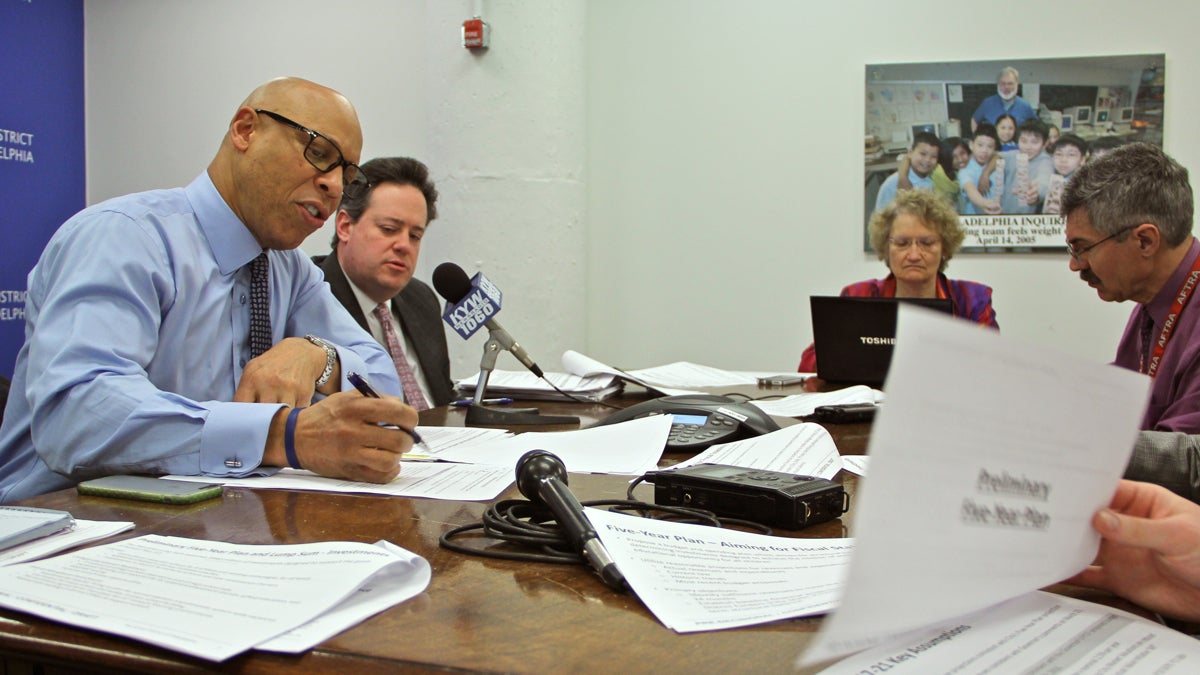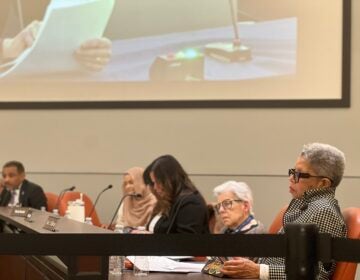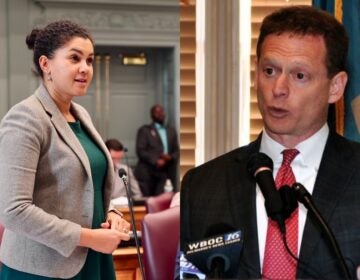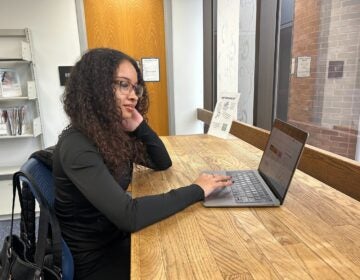Unpacking the details of the five-year plan for Philly schools

Philadelphia schools Superintendent William Hite and Chief Financial Officer Uri Monson review the budget with reporters at School District Headquarters Thursday. (Emma Lee/WHYY)
The School District of Philadelphia last week adopted a plan that calls for $440 million worth of new investments over five years.
The long-term blueprint is contingent, though, on Gov. Tom Wolf getting his way in the next state budget cycle.
Uncertainty remains about the amount of money the district will receive from Pennsylvania this year.
The district anticipates a $52 million boost, but Wolf may try to unilaterally increase that figure by using a distribution formula of his own design. Republican lawmakers say he actually lacks the authority to release any new money because he vetoed the fiscal code bill.
For next year, the district expects the state to give it another $80 million boost — which reflects Wolf’s stated goal.
Given that Wolf’s priorities for last year’s budget haven’t come to fruition, Superintendent William Hite agreed that’s a risky proposition, but balked at the alternative.
“We don’t have another proposal, and so we can’t even go halfway,” he said. “There’s one proposal. That’s the proposal we’re using.”
The new investments the district plans include updated supplies and classrooms, school turnaround efforts, a nurse in every school, and a new contract with the teachers union.
One of the other key assumptions built into the district’s five-year plan is the need to close three district schools annually starting in the 2017-18 school year.
Hite may adjust that recommendation if district enrollment continues to trend upward, but he said the planned course is smart fiscal practice.
“And that is to keep from having to get to a place where we’re making recommendations for 39 schools, like I had to do in 2012-2013,” he said.
Hite called it a natural consequence of approving new charter schools in a time when the city’s public school population has steadily hovered at about 200,000 kids.
Since state legislation forced the district to end its moratorium on new charter expansion in 2014, the School Reform Commission has approved nine charters.
Between these and the natural growth of the rest of the sector, the district expects 10,000 more city charter students in the next five years.
Hite said he hopes to stem the tide of students leaving for charters by opening new schools, and by pursuing school turnarounds and redesigns.
“All of this was to offset the large number of children who were migrating from the district into charters, but the way to do that is to make our schools better,” he said.
In 2012 and 2013, the district ultimately closed 30 schools — a move that SRC member Feather Houston characterized as a painful, yet necessary, reaction to decades of enrollment declines.
“I think that people felt that was tremendously destructive and hard on people in large numbers, and that we shouldn’t do that. [Instead] we should be watching capacity as it develops over time, but then making hard decisions should that materialize,” she said.
SRC chair Marge Neff said the recognition that more closures could be on the way motivated her steady “no” votes on resolutions that expand the charter sector.
“On my mind all the time in making those votes is the negative impact on the district,” she said, “the stranded costs we don’t recover and therefore have to take money away from district schools.”
Charter proponents say closures are a growing pain that reflects the choices of parents who’ve been opting out of neighborhood schools for years.
The district’s five-year plan also acknowledges that some charter school expansion may be unchecked because of a recent state Supreme Court ruling. In February, the court found that the SRC had been exceeding its constitutional authority by unilaterally bypassing the state school code and charter law.
The SRC had been doing so — assuming “extraordinary powers” — to place limits on the charter sector. Without those powers in place, charter schools currently lacking signed enrollment agreements are within legal bounds to expand without the SRC’s permission.
This could result in even more district school closures.
Cost drivers
The charter sector causes other frustrations within the district budget, and represents the largest cost driver in the coming years.
While much of the payments to charters reflect the cost to educate the students those schools serve, Hite says unfair state laws accelerate an imbalance.
If you take all the money the district spends on its own students and its central administration, but back out other non-classroom costs such as debt service, Hite said, the district spends a little less than double what it sends to the charter sector.
The district, though, serves more than twice the number of children that city charters do.
“That’s why we should have a weighted student funding formula that also applies to charters in the same way it applies to districts,” he said.
Hite specifically criticized state law as it pertains to special education. Charters receive the average of what the district spends on special education students — even though the district serves a much larger proportion of children with higher, more costly needs.
This means the system gives charters a perverse incentive to over-identify or enroll kids who need less costly services.
“That’s inherently unfair,” said Hite. “It creates incentives for the wrong types of behaviors.”
The other giant cost driver the district faces is ballooning teacher pension payments — a problem driven in large part by past underfunding by the state.
In 2011, districts paid 5 percent of salaries to the pension fund. In the coming year, the rate will near 30 percent.
The district’s five-year plan does not call for the city to kick in additional money immediately, but that could change.
The district’s revenue sources are set to take two major hits.
The state cigarette tax, which has been generating about $50 million per year, is set to expire in 2019.
Also, the amount the state reimburses the district for things such as pension and Social Security payments is contingent in part based on the wealth of the city’s housing stock. Based on the actual-value initiative, the worth of property increased. So these reimbursements will sink — and at a faster rate than property tax receipts are expected to rise.
In fiscal year 2019, this will mean $61 million less in district coffers.
Despite risks and fears in the waning years of the plan, the immediate fiscal future looks sunnier. After years of shortfalls, the district is budgeting for surpluses in the next three years — but not for all good reasons.
This year’s $134.5 million surplus is mainly driven by the district’s inability to recruit teachers for nearly 200 vacant positions, Hite said. That’s wreaked havoc in many city classrooms this year.
WHYY is your source for fact-based, in-depth journalism and information. As a nonprofit organization, we rely on financial support from readers like you. Please give today.





